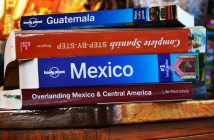As of three and a half weeks into Mexico, chances to practice Spanish are everywhere. Although my language skills are still in their infancy, this does not deter me from enthusiastically engaging in whatever conversation I can.
I walk up to the taco stand in Ciudad Conception, Sven is back in the car. I order a fish taco, Baja’s specialty, from the lady behind the counter: “Buenas tardes. Yo quiero un taco de pescado, por favor.” She asks me a series of questions. Just one? she says. Yes, just one, please. Corn or flour tortilla? she asks. Flour, I reply. As she is preparing it, setting out all of the typical toppings on the counter (cabbage, salsa, lime, pico de gallo – you can add as much of any of these as you like to your taco), I tell her “Yo quiero el taco para….” I do not know the word. I want to tell her that I want to the taco to go. I try a different strategy “No para aquì”, not for here, I say. “Para…” and I make my pointer and ring fingers walk across the counter. I don’t know the word, but she gets my point. “Si, si”, she says, and continues frying the fish that will become beached in my flour tortilla.
“Disculpe, mi Español es muy mal”, I tell her. Sorry for my bad Spanish. “No problema”, she says, “yo entiendo.” She tells me that it’s not a problem that my Spanish is bad, she has understood me, and gives me a wide, gracious smile. I get my taco, choose my toppings, and am on my way with a hearty “Buenas tardes!” I get back to the Bus and start on my taco. It’s awesome.

Un taco de pescado, por favor! Taqueria in Santiago, Baja Sur.
Taking Spanish baby steps
We have been in Mexico for about three weeks now, and my Spanish has been rapidly improving.
Don’t get me wrong – I am still taking my toddling,
wobbly Spanish baby steps. I am on a mere chapter three (of thirty) in
Complete Spanish Step by Step. I have little concept of Spanish grammar, and you may be able to guess at my progress on pronunciation so far. I have made about 300 flash cards, which could be considered to consist of the core of my vocabulary (this is subsidized, of course, by vocabulary that is simple enough to know without a flashcard, easy words like
si (yes), for example, or conjunctions like
pero (but), or prepositions such as
para (for)). I am working on learning to conjugate the few present tense verbs I know, and have learned to build the future tense with
ir.
However, despite all of this progress, my Spanish is very obviously in its infancy, which anyone I am talking to will immediately recognize. I often speak with broken sentences that are still missing key pieces, and I have not yet learned most of the vocabulary that I need on a daily basis. This is also the part of my language progress I consider less important. Rather, the part that is important are conversations like the one with the taco lady, because they focus on communication, not on correctness.
The real deal: language everywhere, all the time
Because this is the real deal. Language learning through pure, raw exposure. In the past three weeks, I have been constantly exposed to Spanish. You hear it in the supermarket, with the guy who is asking you to pay for your campspot on the beach, for official business like visas, and at military checkpoints. They tend to be small moments, but ones where communication is paramount. You are almost forced to use it, as you are confronted with these situations over and over again. And it’s exciting, because every time is a chance to practice again.

Spanish everywhere, every chance I get.
This is immersion, pure and simple. In other words, this is surrounding myself with a foreign language, using every opportunity to practice it, and doing my best with the skills I have at my disposal. Of course, we are by no means always just speaking Spanish. We have been hanging out with other travelers, and the language of choice among ourselves is English. Sven and I usually speak English to each other on the road, although we have been doing our best to speak Spanish with each other in public places like the supermarket or at the local taco stand since we’ve crossed into Mexico.
And even more important than being surrounded by the language – this is immersion because of the speaking aspect. It is about speaking in Spanish, no matter what. Just because I am having a bad day is no excuse to be lazy and speak to the pharmacy attendant in English; Spanish is always the language of choice, no matter how little of it I may be capable of producing. It often takes more than one try before what I am asking for is understood, unless it is something very straightforward and simple.
Getting better by getting it wrong
But it is not about getting it right on the first try. It is much more about the fact that I attempt to tell the lady at the pharmacy that I want to pay at the supermarket checkout (rather than the pharmacy counter) because my boyfriend is over on the other side of the store and has all our cash. And although what I said was in no way correct, it was enough to let her know why I preferred one option over the other. In this regard, I have successfully communicated, even if no sentence I said was actually correct.
Because that’s the whole point: learning language through immersion is about getting better by getting it wrong. Although I am making many mistakes now, as my vocabulary and sense of the language improves over time, I will reduce the number of mistakes I make in the future. There is a point when your sense of a language develops and you don’t forget the verbs or to add an article, when you know if a conjugation sounds wrong. But for now, while I am still taking my Spanish baby steps, mistakes are the key to getting better. It is not just okay to make mistakes while learning a language, it is preferable.
Although I may not know the word for take-out food in this conversation, I will remember the nice lady at the taco stand who taught me para llevar when I am ordering the next taco at the stand down the road. The structured book-learning and vocabulary practice supplement this, and also help me improve my chance of finding the right word buried somewhere in my brain the next time I can’t find the candles in the supermarket. But even if I don’t know the word for candle now, I can try my best to describe it in my bad Spanish until the person I am talking to understands what I am searching for.

Un taco de pescado, para aqui!
Conversation is exhilarating
And it is communication that is the fun part of language. Even if I dutifully learn my flash cards, it is not particularly fun. However, using the words I have learned, remembering them in a real-life situation, that is fun. It is an amazing feeling, talking to people in a foreign language.
This does not just apply to my meager conversation with the lady at the taco stand, however. The skill to order food and communicate things you want or need is essential as a traveler. That is why the typical traveler tends to learn things like ordering food, how to book a room, or how to manage a border crossing first. These are the things they practice a lot. But this is not the part that excites me. What I find fascinating is molding these meager skills into something more pliable. A flexible use of language.
Applying language flexibly
Many people find themselves inhibited when it comes to the application of a foreign language in real situations, despite the fact that they may be very studious. A fear of sounding stupid, of not being understood, of not saying something precise enough – all of these things lead many learners to fear applying the language in real contexts.
Moreover, thoughts like these lead to a fear of applying the language
flexibly. Many tourists get by with even a lot more than just being able to order things at a restaurant, organizing a tour or a hotel room, and managing in conventional situations. It is a broader challenge, however, to take what you have learned and transfer it to situations that are not in the usual tourists’ repertoire. Instead of just being able to talk to the pharmacist, I want to be able to talk about
the importance of a good spare tire, the role
Instagram plays in our trip, or
why our Bus is also named Emma.
Applying language flexibly is using my language skills to communicate any topic I need to. I do not just talk to the lady at the taco stand, but am already free to talk about any topic I wish, using the words that I have integrated into my vocabulary so far.

Sven and Big Emma at a taco stand in Mulegè, Baja Sur. It is difficult to order for myself sometimes, because Sven is proficient in Spanish and is able to jump in quickly with his language skills.
The importance of a good spare tire
The other day, for example, we pulled off the side of the road to see if some
gringos in a Chevy van needed help or tools to change their flat tire. While we were assisting them, a Mexican guy pulled up, whose name I later learned was Damon. After much experimentation, the
gringos learned that their spare tire was not only flat, it also didn’t fit their car. While Sven was busy trying to help them jack their car up, I had a simple but valid conversation with Damon about the importance of having a good spare tire in
places like this, with big stretches of space that could all be considered the middle of nowhere. I didn’t know the words for
tire,
nowhere, or
spare, but I had learned
la rueda (the wheel),
lugar con nada (place with nothing), and
extra. This was sufficient enough for my communication purposes, along with a dose of
un momentos, while I think of the words I want to use.
Despite my numerous flash cards, this is the center of the Tootsie Pop, the sweetest part of the treat. Using language like this, even if I do not know very much, is fun. Although many people think it takes a lot of licking to get to that juicy center, it is not necessary. Bite down hard on your mistakes, and accept them for what they are: a language-learning tool. The center may be easier to reach than you might think.

We learned the importance of a good spare tire up in Alaska, driving the Dalton Highway to the Arctic.










3 Comments
Yummmm…. Fish tacos! We wish we were there to join you. But we’re so glad you’re having a good time.
Chloe says “¡Hola!” to BigEmma. She’s as eager to join you as we are…
…by the way, I loved the Tootsie Pop analogy. Very apropos.
Muchas gracias! Thank you! Big Emma says “venga por aqui!” We spent the last few days hanging out with Scott, his mom, and Dante! I’ve heard Chloe’s up and running again!